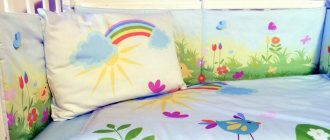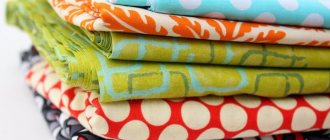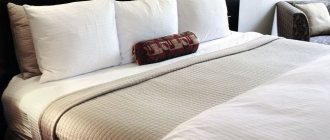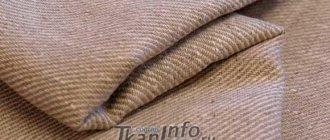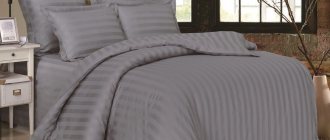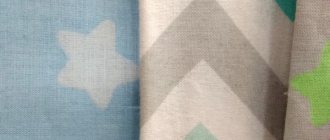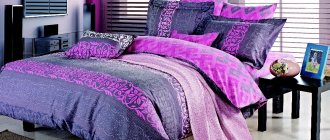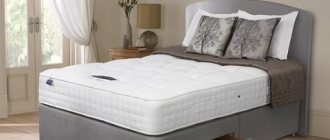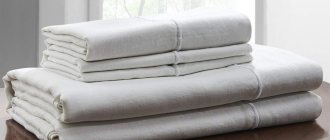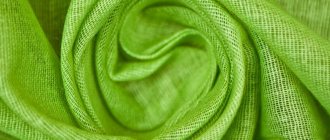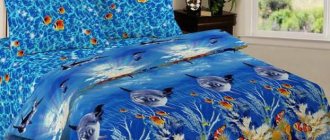An integral accessory in the life of a modern person is bedding: linen, mattress, pillow, blanket. Comfort and quality of sleep, which allows you to fully restore physical and emotional strength, largely depend on the fabric for bed linen. When choosing a material, you should give preference to natural silk, cotton and linen. To maintain health, bed linen should be well breathable and not electrified, while at the same time being beautiful and stylish.
Cotton fabrics
Cotton is considered to be the best fabric for bed linen, which is highly valued for its affordable price, hygroscopicity, and long service life. Cotton fiber is a natural raw material from which fabric is obtained for the production of clothing and textiles. To make the fabric resistant to deformation and elasticity, additives are used: acetate, viscose, polyester. Fibers obtained from cotton fruits are intertwined in various ways. The softness, hardness, and density of the product depends on the type of weaving of fabrics for bed linen, which can be:
- twill;
- linen;
- satin;
- finely patterned.
Natural cotton is used to produce cotton fabrics. Materials for bed linen are classified taking into account texture, density, weaving methods, and processing technology. The most popular ones include flannel, chintz, percale, satin, poplin, calico, cambric, polycotton, ranfors, microfiber.
Percale
Percale is a thin and durable cotton fabric with a plain weave. To achieve excellent consumer characteristics, manufacturers use cotton varieties with long fibers. The soft and silky fabric has amazing strength, which provides bed linen with unique wear resistance. The price of a set of percale linen is higher than that of calico and lower than that of satin. The advantages of percale include hygiene, hypoallergenicity, environmental safety, easy care, and ease of ironing. The fabric does not fade when washed, retains its appearance and shape, does not form pilling, has minimal shrinkage, and is ideal for hot climates.
Chintz
Chintz is an inexpensive fabric with a sparse weave of thick threads. The fabric quickly loses its visual appeal after several washes. The low quality of bed linen is compensated by the low price.
Batiste
Batiste is a light, translucent, unpractical fabric with a plain weave of long-staple cotton threads. Manufacturers produce ivory-colored and white cambric in the following types: printed, plain-dyed, mercerized, bleached. Bed linen made from cambric is expensive, it is presented as an original gift on special occasions - newlyweds, newborns.
Calico
Calico - a dense cross-shaped weave of thick threads is used in the production of this type of fabric. It consists of 100% cotton and occupies a leading position among analogues in terms of environmental and performance indicators. The fabric is highly abrasive and breathable. For sewing bedding sets, bleached, plain-dyed, and printed calico is used. Calico calico is classified into the main types: calico luxury, GOST, standard, comfort, light, ranfors. Among the best is luxury calico - smooth, soft, without pilling. Options GOST, standard, comfort, light - differ in density, the indicators of which determine the quality and cost of the fabric. Ranfors is a particularly dense fabric, the integrity and color palette of which is preserved for many years of intensive use.
Polycotton
Polycotton is a variant of mixed fabric, especially popular for sewing mattresses, pillows, blankets, and bed linen. Synthetic polyester thread is added to calico in various percentages of cotton. Finished products are distinguished by their low price, bright patterns, minimal shrinkage and creasing, and economical powder consumption when washing.
Poplin
Poplin is a light and thin cotton fabric, available bleached or dyed. The second option is classified into plain-dyed, printed, and multi-colored. The bedding sets are made from 100% cotton, the advantages include color and shape stability, comfort of use in winter and summer due to excellent hygroscopicity, environmentally friendly fabric is safe for allergy sufferers. Poplin has high strength, tensile strength, and wear resistance when washed. The fabric practically does not wrinkle, retains heat well, and the weaving of the threads ensures good breathability.
Satin
Satin is a dense and shiny fabric made from double-twisted cotton thread. The lightweight fabric looks like silk; its natural composition provides comfort in warm and cold seasons. Bamboo and polyester fibers give satin its characteristic shine. Velvety and soft fabric is obtained using the satin weaving method. Depending on the appearance, density and composition of the fibers, satin is divided into types:
- Regular satin
is a popular and affordable fabric produced using the satin weave method and is made from 100% cotton. A design is applied to a shiny, soft, medium-smooth fabric using pigment printing. Mercerized fabric acquires additional strength and does not form pellets on the surface. - Printed satin
is a dense, soft, hygienic fabric for bed linen. Painted using the reactive printing method, the design is unusually durable and clear - Printed satin
- 100% cotton fabric, the image is applied taking into account the size of the pillowcase or duvet cover - Satin jacquard
is an elite fabric made of 100% cotton, the pattern is applied during weaving on special jacquard looms. The fabric resembles printed silk; due to mercerization, the smooth fabric acquires additional shine and strength - Stripe satin
is an elite fabric, a type of satin jacquard with a striped pattern. The canvas is painted with natural dyes in pastel, pearlescent, golden tones. Elegant and shiny lingerie sets look luxurious and incredibly attractive - Mako-satin
- called cotton silk, is made from Egyptian raw materials. The smooth, thinnest fabric is dyed using reactive technology. Due to mercerization, the fabric becomes resistant to abrasion and pilling. Soft and shiny fabric for duvet covers and pillowcases retains its shape well and does not deform over time.
The brilliant and bright pattern on satin does not fade and holds the color well. Long-lasting gloss remains after multiple washes. The use of environmentally friendly and high-quality raw materials ensures safety for adults and children.
Sale of bed linen sets
Best prices for bulk purchases
View in the catalog
Flannel
Flannel is the most pleasant bedding material. Soft and unusually delicate cotton fabric allows you to sew a children's set, a set for a cold winter or the off-season.
Ranfos
Ranfors is a fabric made from 100% cotton thread, the weaving density of which is higher than calico and linen. The very strong and durable fabric is uniquely hygienic. Eco-friendly and hypoallergenic products perfectly absorb moisture, create comfortable warmth in winter and coolness in summer. Silky and soft texture suitable for children's underwear.
Microfiber
Microfiber is a 100% cotton fabric that has relatively recently appeared on the bed linen market. Finished products are affordable, easy to maintain, and resistant to deformation. The microfiber cloth practically does not wrinkle, and puffs and pellets do not form on the surface.
Manufacturers rating
The number of brands of bed linen that are sold in our country includes more than a dozen brands. These are both domestic and foreign companies. Among them there are both budget manufacturers and brands designed for a narrow circle of wealthy buyers.
The top 10 manufacturers in Russia are as follows.
- "Monolith".
- “ArtBed”.
- “Vasilisa.”
- “Spalych was sleeping.”
- Verossa.
- “Cotton Paradise.”
- Kazanov.A.
- Cotton Dreams.
- Ecotex.
- “The Owl and the Lark.”
Among imported companies, it is also possible to make a rating of positively proven brands.
- “Blakit” – Belarus.
- TAC, Arya – Türkiye.
- Cleo, Sailid - China.
- Togas - Greece.
- Blumarine - Italy.
Silk fabrics
Bed fabric made of natural silk is one of the elite textiles. The price of the set is quite high, but it is worth paying for the incredible beauty and unique tactile sensations. A special weaving technology and extraordinary strength of the threads extend the life of silk bed linen for decades, while maintaining the sophistication of the pattern and clarity of color rendition. The material is high maintenance and requires delicate washing or professional dry cleaning. Natural silk is hygroscopic, breathable, does not electrify, does not attract dust, and prevents the proliferation of pathogenic microbes.
Natural silk does not cool the skin when touched; its thermal properties quickly adapt to body temperature. The unique shine of the fabric remains for many years, sparkling and shimmering in a variety of shades and halftones depending on the angle of incidence of the light. During use, bed linen practically does not wrinkle, does not slip and does not shock.
Dimensions and composition of the set
Agree, it will be a shame if the new set does not fit in size: the sheet turns out to be smaller than the mattress, or the pillowcases do not fit on the pillows. To prevent this from happening, before you go shopping, you should measure the pillows, blanket and mattress (you need to add the height to the width and length of the bed so that the sheet can be conveniently tucked in).
You should also decide on the configuration: how many pillows you have, one or two blankets you use.
When all the necessary data has been collected, you should select the required size in the table below.
Linen fabrics
Linen bed linen sets are made from environmentally friendly natural raw materials of high quality. Finished products are characterized by high density and long service life. The texture of the fabric has characteristic knots and slight rigidity. The micromassage effect that flax fibers have on the body allows you to relieve fatigue and irritation accumulated during the day.
Universal textiles create thermal comfort: pleasantly cool in the summer heat and warm in the winter cold. The fabric consists of micropores through which air circulates effectively. The hygroscopic fabric absorbs sweat, while remaining dry due to the fact that droplet moisture quickly evaporates from the surface. The hypoallergenic properties of natural material are especially relevant for adults and children suffering from allergic diseases. The bactericidal properties of flax fibers prevent the formation of microbes, fungi, and skin inflammation. The fabric does not accumulate static electricity.
To obtain the strongest material, traditional fiber spinning technologies are used. This allows you to give the threads of linen fabric the following properties:
- mechanical strength, abrasion resistance;
- hygroscopicity, heat resistance, light resistance;
- chemical resistance.
Bed linen made of natural linen wrinkles, but does not slip or slide off the bed. It is very easy to care for; regular washing allows you to maintain the premium appearance of the products, maintaining a magnificent appearance. Modern manufacturers use high quality fabrics to sew stylish bed linen of any size. Consumers can choose from traditional options made from 100% flax, as well as softened using special technology, and mixed ones made from flax and cotton.
Homogeneous fabric of natural shades is resistant to high temperatures and does not turn yellow over time. Bed linen can be boiled if necessary. For dyed ones, washing with a temperature of +60ºС is recommended. You can avoid additional creasing if you carefully straighten the product when drying. When ironing, the steam function is allowed.
Paint and smell
The quality of the paint can be easily determined by the smell: the new thing should smell only like textiles. A pungent chemical aroma and moldy odor indicate low-grade dye. Such a product will quickly fade, can stain the skin and provoke the development of allergies.
You can check the durability of the paint in the store - simply rub the surface with your palm or a clean cotton pad. If there are no traces, then everything is fine.
On the reverse side, the items in the set should also have almost the same intensity of the pattern as on the front. If it is not there, then the paint is applied on top and will quickly wear off.
There is one more sign by which you can indirectly determine the characteristics of painting. Look on the label for information about the permissible washing temperature. If the value is 60 degrees, then most likely the resistance is high.
The best fabric for baby clothes
To organize a child’s sleeping place and ensure maximum comfort during rest, it is necessary to take a responsible approach to the choice of bed linen. It must be of high quality, have a pleasant tactile sensation, meet safety requirements, have the correct size and be liked by the baby.
When choosing a material, you should be guided by the following criteria:
- hypoallergenic
- it is better to choose natural fabric, since synthetic fibers can cause an allergic reaction; - comfort
- the fabric should be strong, durable and pleasant to the touch; - environmentally friendly
- there should be no toxic dyes or harmful chemicals; - air permeability
- linen should allow air to pass through well to create a comfortable microclimate; - ease of care
- children's bedding is often washed, so the fabric must withstand numerous washes, retain color and shape.
The most suitable option for children's bedding is cotton. Natural material is relevant in winter and summer, perfectly absorbs excess moisture and creates ideal conditions for a night's rest. The softest material for children's bedding, flannel, is very popular. It has all the advantages of a cotton-based material, is incredibly soft and evokes positive emotions when touched.
Before purchasing the set you like, you should pay attention to the dimensions. For a baby, underwear with dimensions of 110x140 cm for a sheet and duvet cover is suitable, for a pillowcase - 50x40 cm or 50x60 cm. For a schoolchild, you should choose underwear for a single bed - 215x145 cm and 70x70 cm for a pillowcase. Options “for growth” are not desirable because they cause discomfort when used.
From a rich range of colors, you should choose plain options with delicate pastel shades. This color has a calming effect, setting you up for relaxation and sound sleep. Images of popular cartoon and comic characters are allowed. For girls it is worth choosing pink, pistachio, yellow, soft lilac, beige shades, and for boys blue, green, turquoise colors are suitable.
The quality of bed linen for children must be at a high level. The lines are even, without creases or bends, without a pronounced relief texture. For babies, it is recommended to avoid appliqués, inserts, and excessive fringe and braid details.
Sale of bed linen sets
Best prices for bulk purchases
View in the catalog
Color and finishing
The wild imagination of designers knows no bounds. Here you will find floral patterns, geometric designs, cartoon characters, and even entire paintings with a 3D effect. Choose to your taste, but some tips still need to be taken into account:
- white and muted pastel shades look good in any setting and do not have an impact on the psyche;
- blue, indigo and violet create a harmonious atmosphere and have a calming effect;
- red is the “color of passion”; its excessive activity can irritate;
- pink creates a romantic mood;
- yellow gives a burst of energy.
In addition to color and pattern, some models are decorated with lace trim, embroidery, frills, piping and other decorative elements. As a rule, they are found on expensive products. But in the pursuit of beauty, one should not forget about practicality: all this splendor should not interfere during sleep or during the process of washing bed linen.
You should not buy models with buttons, zippers and other accessories. During operation it breaks, comes off, and even presses and rubs. This rule is doubly relevant for children's products.
Attention to detail when choosing bedding
There are several factors to consider when purchasing bedding. These include:
- Size.
The most common sizes are single, euro and double. The parameters are determined by the type of bed, as well as who the product is intended for. - Density and type of fabric.
When choosing a fabric, it is important to consider its ability to absorb and evaporate moisture and allow air to pass through. Natural materials - cotton, silk and linen - are environmentally friendly and safe for health. The strength of the fabric affects the durability of the bed linen. Excessively delicate and soft material requires careful washing, otherwise holes may appear. - Packaging.
The quality of packaging indicates the manufacturer’s attitude towards the product and the client. Dense materials, beautiful appearance and neatness are the criteria for a good product. The label must provide detailed information about the brand, size, type and composition of fabric, and care features for the product. - Seams.
To determine the quality of bed linen, it is necessary to examine its reverse side. Products of this type are sewn with a linen seam. Untreated edges will cause damage to the material after washing. The threads of the seams are matched to the color of the fabric; they must be strong and durable. - Smell.
New bed linen has a pleasant textile aroma. A pronounced smell of paint and dampness is evidence of the poor quality of the material. The fabric can quickly lose its rich color and cause allergic reactions. - Design.
The design of bed linen depends on personal preference. Typically, the color palette of the product fits into the bedroom interior. The most universal shades are beige, coffee, mustard, gray, as well as black and white.
Package
The packaging will tell you a lot about its contents. It must contain all the information about the product: the type of fabric and its composition, what is included in the set and care recommendations. In addition, the name and coordinates of the manufacturer are indicated here, along with the address and telephone number.
Evaluate the design of the label: the picture should not be blurred, all letters should be clearly printed, naturally, without grammatical errors (Chinese products are famous for this).
Make sure that the packaging is intact and that the filling is reliably protected from dirt and moisture.
If you are purchasing a set as a gift, it is better to choose a beautifully packaged model. This could be a branded bag, a box tied with a ribbon, etc.
Color fastness
The stability of the pigment depends on the type of dye and the method of application by the manufacturer. It is difficult to recognize the durability of the paint used by eye, but do not despair.
The pigment for coloring is divided on a 5-point scale, the optimal indicator for pillowcases, sheets and duvet covers: 4.
Important! Check the label for the optimal washing temperature. The higher the temperature, the more stable the coloring.
Rub the material of the linen well with your palm; if the paint is resistant, then there should be no marks left on your hand.
Percale
“Royal” fabric made in the best Irish traditions. Can be made from: linen, cotton, cotton base mixed with synthetic fiber. The special smoothness of the fabric is given by a unique manufacturing method - sizing, which literally glues the fibers together.
Advantages: the fabric is strong, durable, not prone to deformation, does not fade, has excellent air permeability, absorbs moisture, does not cause allergic reactions, and is moderately expensive.
Disadvantages: none found.
We hope our article will help you make your choice. Happy shopping and sweet dreams!
Classification
Linen fabric is classified according to several criteria. The composition and density of the material are usually taken as a basis. In addition to these qualities, ready-made kits vary in size.
By composition
Bed linen can have a natural, synthetic or mixed composition. The last option is considered the best, since it successfully combines price with quality.
By density
This parameter shows how many threads are in 1 cm² of fabric. If there are up to 32 of them, then the density is low. 32-42 threads mean below average density, 55-65 average, and 65-85 above average. A high indicator is when there are 85-130 threads in 1 cm². If there are more of them, this is extra class.
Fact! The higher the density of bedding fabric, the better and more durable. Average values for cotton and linen, low for cambric, high for artificial fabrics, Turkish and Japanese silk, satin, percale.
KPB sizes
Ready-made bedding sets come in different sizes. You need to choose an option based on the dimensions of the sleeping place, the length and width of the pillows.
There are the following sizes of kpb:
| Type of kit | Bed sheet size | Duvet cover size | Pillowcase size |
| Children's | 110x140 | 110x140 | 40x60 |
| For a newborn baby | 120x150 | 110x150 (112x147) | 40x60 (40) |
| 1 bedroom | 110x200 | 135x200 | 50x70 |
| 1.5 bedroom (teenage) | 180x220 | 145x215 | 70x70 |
| 2 bedroom | 180x220 | 175x215 | 70x70 |
| Family | 220x240 | 145x215 (2 pieces) | 50 (70)x70 |
| Euro | 220x240 | 200x220 | 50 (70)x70 |
| King size (Euro) | 220x240 | 220x240 | 50 (70)x50 (70) |
| Euro for newborn | 120x170 | 100x120 | 40x60 |
There are other size options. When purchasing, you should pay attention to the line of a specific manufacturer.
Important! The inscription single or 1-bed means one pillowcase included. A bedding set from Germany or Austria often includes only a duvet cover with pillowcases.
We determine the quality of the kit upon purchase
You need to choose bedding based on several indicators. One of them is good quality. The following signs indicate it:
- absence of a sharp, unpleasant chemical odor;
- straight linen seams in the color of the fabric, without tears or sagging;
- no significant difference between the color of the front surface and the back;
- presence of basic information on the label;
- compliance with the specified dimensions.
The quality of not only the bed linen itself is important, but also its packaging and labels.
Satin Lux
The fabric is made from two different fibers using satin weaving. Thanks to this, it has two sides: shiny and matte.
Advantages: the fabric is temperature-controlled, environmentally friendly, does not cause allergic reactions and perfectly retains its shape and color even after many washes.
Disadvantages: since the fabric belongs to the elite category, it is quite expensive.
Requirements for materials
When choosing which fabric is best for bed linen, you need to start from the requirements for it:
- hypoallergenic;
- breathability;
- minimal creasing;
- hygroscopicity;
- high density;
- wear resistance;
- good thermal insulation;
- high-quality durable coloring;
- safety.
The pillability of bedding fabric is important, that is, the tendency to form pills.
